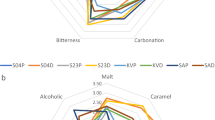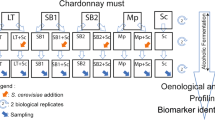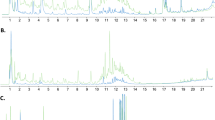Abstract
DIACETYL is an important component in the flavour of food and it is known to be the chief component of the aroma of butter. We have shown that it is also found in distilled alcoholic beverages, such as whisky and cognac. The formation of diacetyl in yeast fermentation has long been known1 and extensive studies have been made of its appearance and influence on the aroma of beer. There is still much confusion about the mechanism of its formation2–4, however, partly because of analytical difficulties. Maule et al.5 have proved that the colorimetric determination of diacetyl requiring frac-tionation by distillation may give values which are erroneous and too high in comparison with those obtained by gas chromatography with an electron capture detector.
This is a preview of subscription content, access via your institution
Access options
Subscribe to this journal
Receive 51 print issues and online access
$199.00 per year
only $3.90 per issue
Buy this article
- Purchase on Springer Link
- Instant access to full article PDF
Prices may be subject to local taxes which are calculated during checkout
Similar content being viewed by others
References
Suomalainen, H., and Jäannes, L., Nature, 157, 336 (1946).
Suomalainen, H., and Linnahalme, T., Arch. Biochem. Biophys., 114, 502 (1966).
Magee, P. T., and de Robichon-Szulmajster, H., Europ. J. Biochem., 3, 502 (1968).
Chuang, L. F., and Collins, E. B., J. Bacteriol., 95, 2083 (1968).
Maule, D. R., Pinnegar, M. A., Portno, A. D., and Whitear, A. L., J. Inst. Brewing, 72, 488 (1966).
Portno, A. D., J. Inst. Brewing, 72, 458 (1966).
Harrison, G. A. F., Byrne, W. J., and Collins, E., J. Inst. Brewing, 71, 336 (1965).
Lewis, K. F., and Weinhouse, S., J. Amer. Chem. Soc., 80, 4913 (1958).
Suomalainen, H., and Keränen, A. J. A., J. Inst. Brewing, 73, 477 (1967).
Krampitz, L. O., Arch. Biochem., 17, 81 (1948).
Yoshizawa, K., Agric. Biol. Chem. (Tokyo), 28, 279 (1964).
Holzer, H., and Beaucamp, K., Biochim. Biophys. Acta, 46, 225 (1961).
Holzer, H., Da Fonseca-Wollheim, F., Kohlhaw, G., and Woenckhaus, Ch. W., Ann. NY Acad. Sci., 98, 453 (1962).
Carlson, G. L., and Brown, G. M., J. Biol. Chem., 236, 2099 (1961).
Ullrich, J., Wittorf, J. H., and Gubler, C. J., Biochim. Biophys. Acta, 113, 595 (1966).
Speckman, R. A., and Collins, E. B., J. Bacteriol., 95, 174 (1968).
Owades, J. L., Maresca, L., and Rubin, G., Amer. Soc. Brewing Chemists, Proc., 1959, 22.
Portno, A. D., J. Inst. Brewing, 72, 193 (1966).
Magee, P. T., and De Robichon-Szulmajster, H., Europ. J. Biochem., 3, 507 (1968).
Author information
Authors and Affiliations
Rights and permissions
About this article
Cite this article
SUOMALAINEN, H., RONKAINEN, P. Mechanism of Diacetyl Formation in Yeast Fermentation. Nature 220, 792–793 (1968). https://doi.org/10.1038/220792a0
Received:
Issue Date:
DOI: https://doi.org/10.1038/220792a0
This article is cited by
-
Influence of valine and other amino acids on total diacetyl and 2,3-pentanedione levels during fermentation of brewer’s wort
Applied Microbiology and Biotechnology (2013)
-
Optimization and mechanism of diacetyl accumulation by Enterobacter aerogenes mutant UV-3
World Journal of Microbiology and Biotechnology (2009)
-
Bildung von Diacetyl und Pentandion-(2,3) inPediococcus cerevisiae
Die Naturwissenschaften (1969)
Comments
By submitting a comment you agree to abide by our Terms and Community Guidelines. If you find something abusive or that does not comply with our terms or guidelines please flag it as inappropriate.



